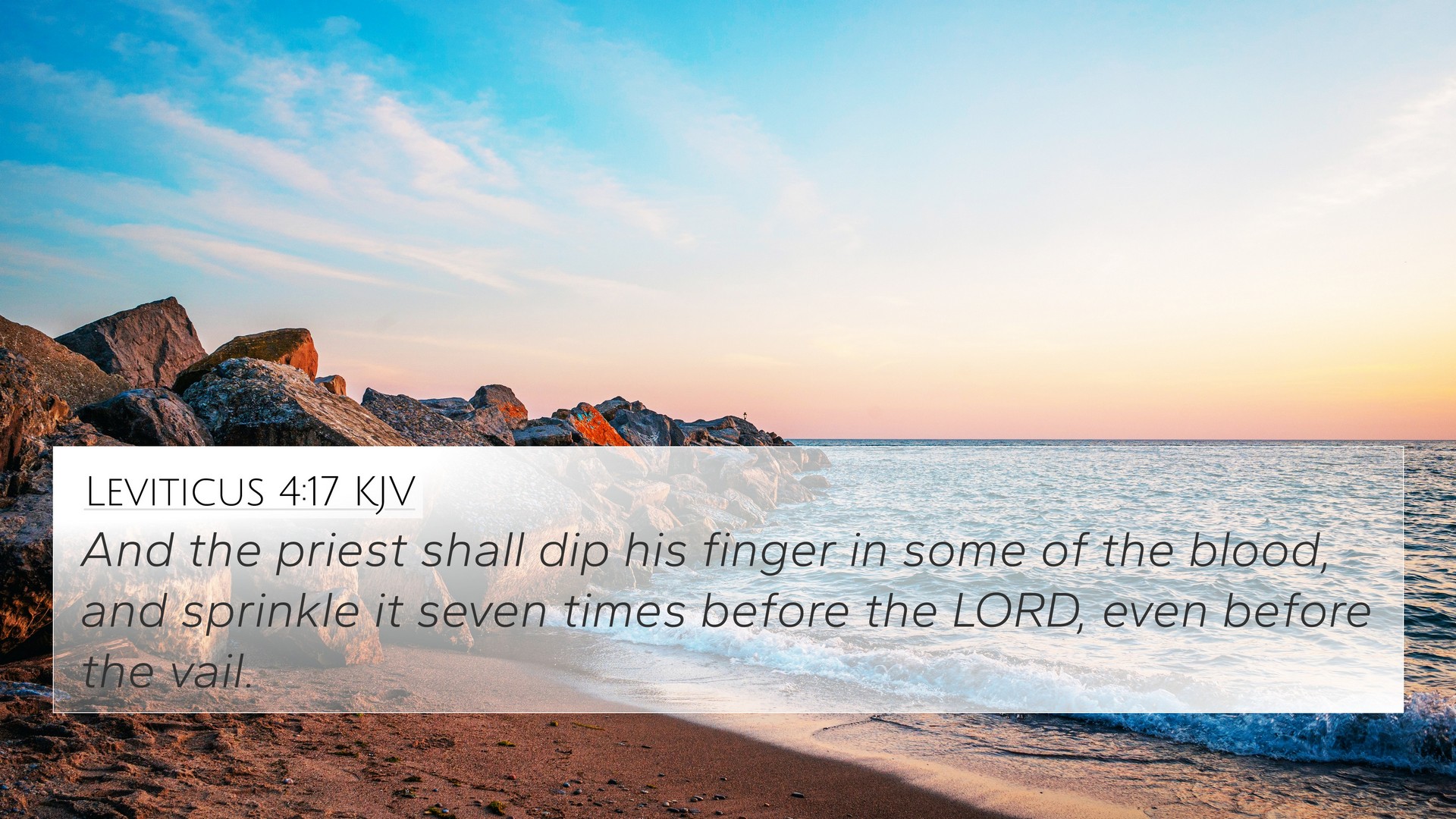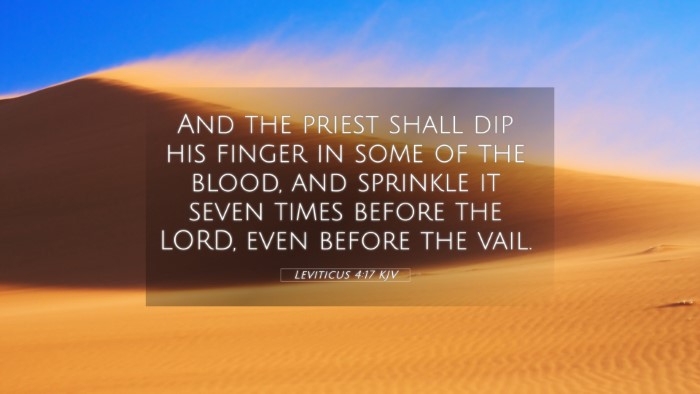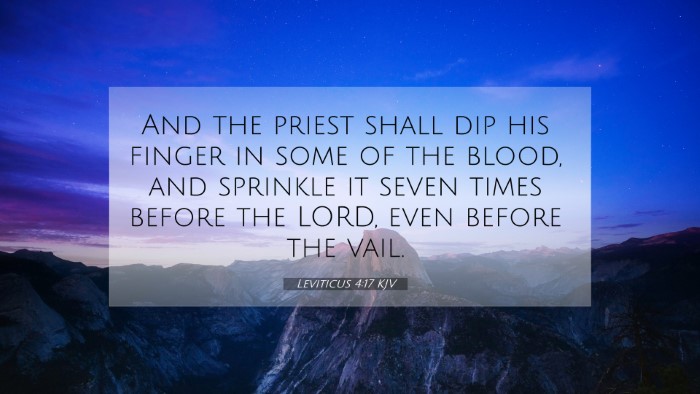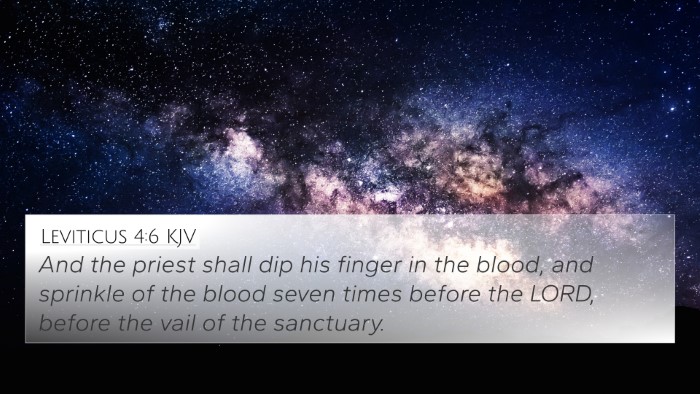Understanding Leviticus 4:17
Leviticus 4:17 states:
"And the priest shall sprinkle of the blood upon the wall of the altar that is before the Lord, which is in the tabernacle of the congregation, and shall pour out all the blood at the bottom of the altar of the burnt offering, which is at the door of the tabernacle of the congregation."
Summary of Meaning
This verse emphasizes the ritual of atonement and the significance of blood in the sacrificial system of the Old Testament. Blood was essential in the process of making amends for sin, illustrating both the severity of sin and God’s provision for reconciliation.
Commentary Insights
-
Matthew Henry:
Henry highlights that the act of sprinkling the blood was vital in the sacrificial system as it symbolized cleansing and the transfer of sin away from the sinner. The rituals served not only as religious observances but also as profound lessons on the seriousness of sin and the holiness of God.
-
Albert Barnes:
Barnes adds that the priest plays a critical role in mediating between God and the people. The sprinkling of blood on the altar signifies the atonement for sins, demonstrating how the innocent take on the punishment of the guilty, foreshadowing the ultimate sacrifice of Christ.
-
Adam Clarke:
Clarke focuses on the symbolic meanings within this ritual. He notes that the blood was to be poured at the altar of burnt offerings as a way to symbolize the complete surrender of oneself to God. It was an act that demonstrated devotion and acknowledgment of God’s covenant with Israel.
Connections to Other Bible Verses
Leviticus 4:17 provides a foundation for understanding various themes in the Bible, particularly those revolving around sin, sacrifice, and atonement. Here are some significant cross-references:
- Hebrews 9:22: "And almost all things are by the law purged with blood; and without shedding of blood is no remission." This New Testament verse underscores the necessity of blood for atonement.
- Exodus 12:7: "And they shall take of the blood, and strike it on the two side posts and on the upper door post of the houses wherein they shall eat it." This relates to the Passover and the significance of blood in protection and deliverance.
- Romans 3:25: "Whom God hath set forth to be a propitiation through faith in his blood, to declare his righteousness for the remission of sins..." This reflects the theological link between the Old Testament sacrifices and Christ’s atoning death.
- Leviticus 17:11: "For the life of the flesh is in the blood: and I have given it to you upon the altar to make an atonement for your souls..." This verse provides the rationale for the sacrificial system, emphasizing the sacredness of blood.
- 1 Peter 1:18-19: "Forasmuch as ye know that ye were not redeemed with corruptible things, as silver and gold, from your vain conversation received by tradition from your fathers; But with the precious blood of Christ, as of a lamb without blemish and without spot." This connects the Old Testament sacrificial system with the New Testament’s fulfillment in Christ.
- Isaiah 53:5: "But he was wounded for our transgressions, he was bruised for our iniquities: the chastisement of our peace was upon him; and with his stripes we are healed." This prophetic verse illustrates the concept of substitutionary sacrifice.
- Hebrews 10:4: "For it is not possible that the blood of bulls and of goats should take away sins." This verse shows a contrast between the repeated sacrifices of the Old Testament and the once-for-all sacrifice of Christ.
Exploring the Themes
The themes arising from Leviticus 4:17 and its related passages include:
- Atonement: The sacrificial system demonstrated the need for atonement and foreshadowed the ultimate sacrifice of Jesus.
- Holiness: The rituals reflect God’s demand for holiness and the seriousness of sin.
- Substitution: The principle of blood as a substitution for the penalty of sin highlights God’s merciful nature.
- Redemption: The act of atonement provides a pathway to redemption, fundamental to Christian theology.
The Importance of Cross-Referencing
Cross-referencing Bible verses such as Leviticus 4:17 with New Testament scriptures allows for a deeper understanding of Biblical theology. It reinforces the continuity of God’s plan throughout scripture.
Utilizing tools for Bible cross-referencing, such as a Bible concordance or Bible cross-reference guide, can aid in discovering thematic Bible verse connections and facilitate a more comprehensive understanding of inter-Biblical dialogue.
Conclusion
Leviticus 4:17 serves as a crucial verse within the sacrificial framework of the Old Testament, establishing the concept of atonement through blood. Through comparative Bible verse analysis and inter-Biblical connections, one can appreciate the depth of this ritual, not merely as an ancient practice but as a pivotal moment that informs Christian doctrine and faith.



